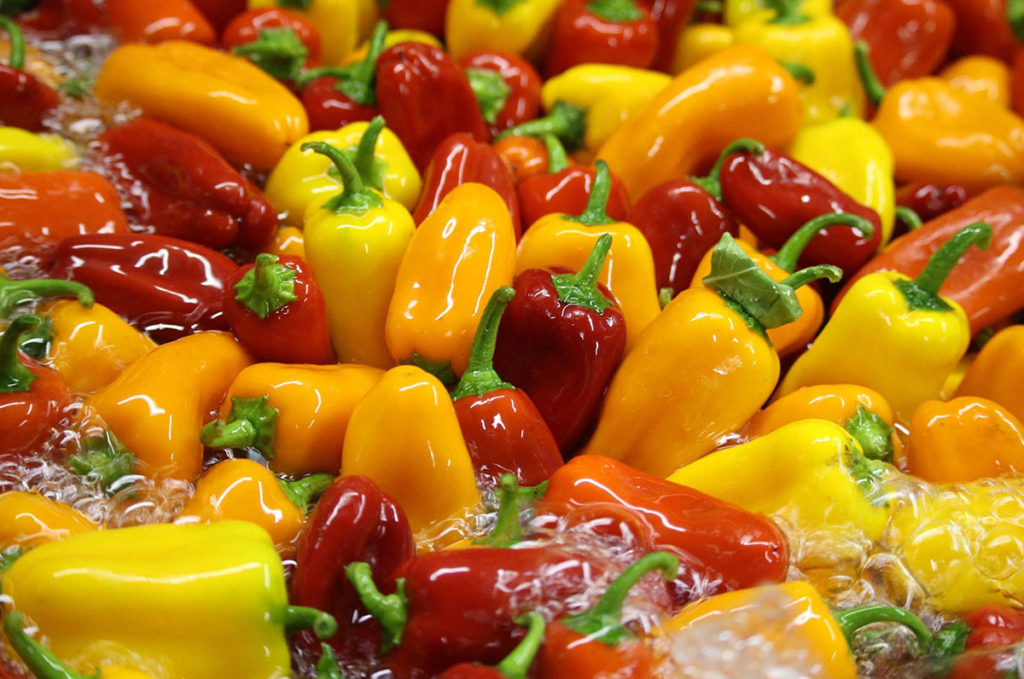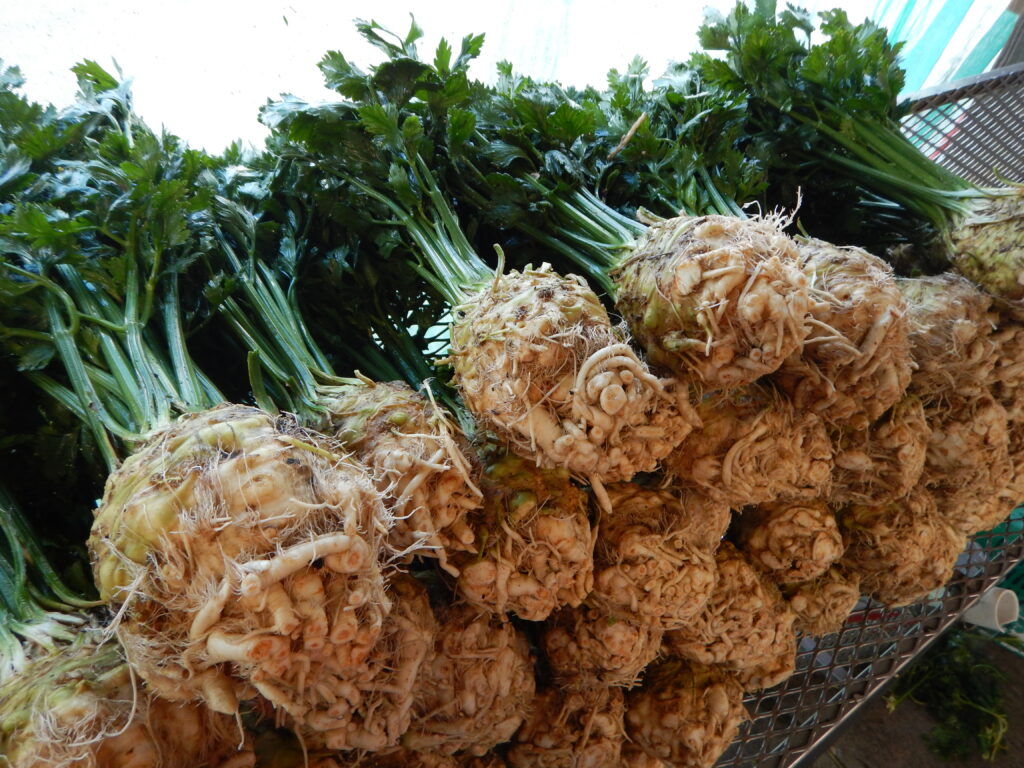What’s In The Box with Recipe Suggestions
Carrots: Making tomato sauce? Include carrots (and other vegetables) as your secret ingredient to add sweetness to the sauce and balance the acidity from the tomatoes! Not to mention hiding vegetables from those in your household that may not enjoy eating them.
Cucumbers and/or Zucchini : Pair this week’s cucumbers with tomatoes to make a Cucumber, Tomato Salad with Olives and Feta. This looks like this will be our last week for both zucchini and cucumbers for the season! If you haven’t used all your zucchini yet, you can shred and freeze it for later use in recipes too!
Edamame: It’s easiest to shell edamame if you first cook it in boiling water for several minutes. Once cooked and shelled, add it to pasta or vegetable salads or just eat it as a snack!
Sushi Salad with Brown Rice, Edamame, Nori and Miso Dressing
Italian Garlic: Use this week’s garlic to make Garlic Scented Tomato Salad.
Sugar Cube or Sweet Sarah Melons: Most boxes will contain Sugar Cube melons. These are small, round, netted melons that do not have ridges. Enjoy what may be our last taste of melons this season.
Red & Yellow Onions: Caramelized onions are the key to Pizza in the Roman Way, a recipe we featured in our newsletter several years ago (2017). Aside from a flatbread or pizza crust base, the only other ingredients you need are onions, olive oil, oregano and salt!
Fried Rice with Edamame and Corn
Jalapeño Pepper: There is one spicy little green jalapeño packed loose in your box. Use it to spice up your pot of chili!
Mini Sweet Peppers: In this week’s box you’ll find a colorful 1-pound bag of these sweet, flavorful peppers. This is a great snacking pepper, on its own or cut them in half, remove the stem and seeds and stuff them with your favorite filling. Try stuffing them with vegetable cream cheese!
Red Pepper, Lentil & Tomato Salad
Sweet Corn: This week looks like our peak sweet corn week, and we have one more crop to go! You need to keep your sweet corn cold to preserve its sweetness and we recommend eating it within a day or two for the maximum flavor.
Sun Orange, Chocolate Sprinkles, or Red Grape Tomatoes: Any of these small tomatoes are good choices for putting on a skewer along with zucchini, onions, peppers and either chicken, beef or tofu to make kabobs for the grill!
Variety of Tomatoes: Ripen tomatoes at room temperature and avoid storing them in the refrigerator for any lengthy time. Enjoy slices of fresh tomatoes sprinkled with coarse sea salt and a drizzle of olive oil.
Cucumber, Tomato Salad with Olives and Feta
Red Seedless Watermelon: We only grow small varieties so they will fit in your CSA box and still allow room for other items! Handle your bags carefully when picking up your CSA shares this week as the watermelons can be brittle and may crack if not handled gently.
Vegetable Feature: Mini Sweet Peppers

These sweet little peppers have become something many of our members look forward to every year! They are beautiful, colorful, sweet and easy to eat. They travel well, require very little if any preparation, store well on the countertop during the season and are easy to preserve. They are delicious raw, roasted, sautéed and are excellent for dipping or stuffing. They can even be frozen and used later in the winter!
For those of you who have been members with our farm for several years, you are likely to remember the story about how this vegetable came to be part of our vegetable team. We are grateful to one of our longtime CSA members who introduced us to them. Upon his suggestion, Richard picked up a pack of these peppers at the co-op and saved the seeds from them. Please note, each pepper only has a few seeds inside, so the amount of seed we had to start with was pretty slim. He planted out the seeds that year, selected more peppers to save seeds from and thus began the process of developing our own line of seed. At the time, they were not very widespread in the stores as they are now, and seed was not commercially available in this country. Times have changed and mini-sweet peppers, or snacking peppers as they are also called, are now carried in most stores and co-ops. Seed is now commercially available in this country. Several years ago, we purchased some seed to try. We grew it side by side with the seed we had saved and when we looked at the plants in the field, they were pretty similar. We almost had ourselves convinced that we should just purchase seeds and stop spending painstaking time picking 4-5 seeds out of peppers at the end of every summer so we have seed for the next year. But then we tasted them. One bite of the variety purchased stopped us in our tracks. It was an acceptable sweet pepper, but it did not have the level of sweetness or the depth of flavor we experienced with the variety we’ve been developing. We haven’t purchased seed since then and will continue to refine the seed we save every year as it seems to be doing pretty well in our growing environment.
So, what do you do with this little pepper? Well, the easiest thing to do is to just eat it as a snack. You don’t even cut them or trim away the top, just use the stem as a handle and eat around the seeds. One of Richard’s favorite ways to eat this pepper is stuffed with cream cheese or other soft cheese. You can eat peppers stuffed this way raw or pop them under the broiler for a bit to warm them up. This pepper is also great roasted. Lastly, you can use this pepper as you would any other sweet pepper.
As mentioned above, it can also be preserved. This is actually one of the easiest things to put away for winter. All you have to do is wash them, let them air dry a bit and then put them in a freezer bag and freeze. That’s it. When you’re ready to use them, take out the portion you need and leave them on the counter at room temperature for just a few minutes so it softens enough for you to cut them. We use these throughout the winter as a topping on pizza, added to soups and stews, or chopped and added to rice and pasta dishes.
We hope you enjoy this sweet little gem as much as we do!
Short & Sweet Weekly Farm Update
Last week it cooled down a little. This week is downright cold in the mornings. We are starting to look at our fall crops! Two spinach and salad plantings are sprouted and looking strong. We have lots of Daikon radish planted for later this fall/winter. Just this week, we started harvesting celeriac. The winter squash is almost ready to harvest, and we will soon see leeks, cauliflower and cabbage in our CSA boxes too!

Update on our Food Safety inspection. We were far behind where we needed to be in our written HACCP (Hazard Analysis and Critical Control Point) Plan in order to pass this years inspection. Mellissa took the lead with our new HACCP team and training. We already thought she was a rockstar, but our inspector, Dr. Kolb does too! His exact words, “Mellissa, Congratulations, I have never seen a HACCP program, in 35 years in this industry, so well prepared and through. It is awesome and fantastic. Not to mention it is formatted correctly, referenced and in a document control manner. You deserve tremendous ‘Very well done -Award!” Then he went on with a couple of suggestions/changes and ended with “THIS IS A GREAT HACCP – ONE OF THE BEST EVER.” We couldn’t agree more, Mellissa studied how to write the plan, talked with our whole farm team and led our new HACCP team to this point, and she did it all with a smile and great attitude. A few more minor steps (mock traceback report, trace flow chart and annual review documents) and we will be all set. Thank you to Mellissa for stepping in and up when needed and to the rest of the HACCP team for working though this to get our new Food Safety Certificate!



